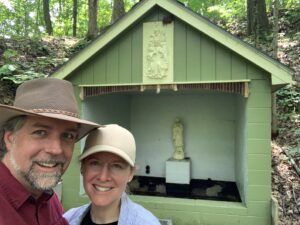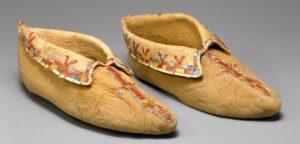Feast Day: July 14
Last Wednesday I blessed myself with water used to baptize a saint. I don’t think I’ve ever done that before. An hour west of Albany, just off the busy NY Thruway and then past a mile of truck stops, the Franciscans manage a little oasis of peace centered around a Mohawk girl. There, at the Saint Kateri Tekakwitha National Shrine they maintain a chapel and the forgotten remains of her home village, which they had helped discover and excavate. A hillside spring flows a hundred yards outside the village’s stockade and longhouses. On Easter Sunday, 1676, Kateri bent her head over that water and received baptism. Four years later she was dead, but her living reputation for holiness immediately attracted people to her grave to pray for her intercession.
My wife and I came to the shrine and spring in part because, as residents of Upstate New York, we think it’s really cool to have a local saint. I also wanted to get to know her, to understand something more about her than the standard description of her as the “first Native American saint” (which actually is untrue—John Paul II canonized St. Juan Diego ten years before her and other Native Americans are in the saintly pipeline). The story I found is both sad and hopeful.

Tekakwitha and her World
The Mohawks belonged to the Six Nations, a confederation of the Haudenosaunee people (also called the Iroquois) that had become the preeminent power in the American northeast thanks to their innovative democratic federal government and aggressive military strength (the sport of lacrosse actually comes from their training program for young warriors). The arrival of the English and French in the 1600s changed their world and started an encounter that would shape Tekakwitha’s life.
As new diseases such as smallpox exploded, the Six Nations responded by increasing raids on neighboring tribes to kidnap young men and women to forcibly adopt. Tekakwitha’s mother, an Algonquin convert to Christianity, was one of those women taken from her home and forced to marry a Mohawk chief. They had a little girl. Four years later, a wave of smallpox swept through their village. Both parents died. The young girl survived—barely. Permanent smallpox scars covered her face. She lost some of her vision, becoming very near-sighted. She became physically clumsy. Her aunt and uncle, who took care of her, named her Tekakwitha, which means “she who bumps into things.”

Instead of going out to the fields with the other young girls, Tekakwitha remained in the village doing tasks such as beadwork. In the partial darkness clouding her vision, scarred, orphaned, and feeling isolated, Tekakwitha began to turn inward. She found God in the depths of her soul. According to the written accounts of priests who knew her later in life, Tekakwitha embraced her mother’s Catholic faith even from this young age, shunning the ceremonies of the Mohawk’s traditional religion and reaching out to support those who, like her mother, had been dragged to the village as captives. Later Mohawk oral tradition disagrees, saying that Tekakwitha embraced the rituals of Mohawk life and began her spiritual journey within their culture’s mysticism. If so, that path brought her back to Christianity.
When Tekakwitha turned thirteen, she made a decisive choice for Christianity. Her uncle and aunt arranged a marriage with a young Mohawk man. She refused them. She wanted to devote her life to one man only: Jesus. This defiance of custom and of the authority of her elders isolated her more. What could one do with this oddball girl who refused to fulfill her most basic social duties?

Tekakwitha wasn’t even baptized at that point. French Jesuit missionaries had been absent from the Six Nations since the late 1640s when the Haudenosaunee had expelled some missionaries and gruesomely tortured the rest to death (to be fair, the French, Algonquin, and other Native American opponents of the Six Nations also fought viciously). In 1667, when Tekakwitha was eleven, three Jesuits visited her village to negotiate their return as part of a larger French-Six Nations peace treaty. In 1670, the Jesuits risked establishing a permanent mission. Tekakwitha impressed the Jesuits with her holy demeanor, her constant prayer, and quiet refusal to compromise her values. On Easter Sunday 1676, despite her uncle’s opposition, she received baptism and took the name Kateri (after St. Catherine of Siena).
Kateri: Holiness in Suffering
A year later, the priest who baptized Kateri wrote to the pastor of a Christian Algonquin village near Montreal:
“Katharine Tekakwitha is going to live at the Sault. Will you kindly undertake to direct her? You will soon know what a treasure we have sent you. Guard it well! May it profit in your hands, for the glory of God and the salvation of a soul that is certainly very dear to Him.”
Life in Kateri’s home village of Caughnawaga had reached a crisis point. In both European and Native American societies, religion wasn’t something individuals did in their free time; it was an inextricable framework of society shaping community, relationships, and government. As native people converted to Christianity, they found themselves at odds with their own communities (as, for example, Kateri did in refusing to marry). Many native converts chose to leave their homes, which in turn reinforced suspicion about the loyalty of the remaining converts. Kateri, already an easy target due to her youth, introversion, and scars, experienced a daily grind of baffled hostility that grew the more she immersed herself in Christian devotions. Her relationship with her uncle steadily worsened. Contemporary written sources say that she suffered beatings and violence (though the later Mohawk tradition denies it). Finally she decided to flee in the night to live in a Christian society among her mother’s people.
Kateri found at least one deep friendship at the mission village with another native Christian woman named Marie Therese and became a beloved protege of the Jesuit priest there. There she received her First Communion. She took an official vow of celibacy, dedicating her life to God. She even proposed founding a religious order for native women along with her friend, but the priests refused since she had only just officially entered the Church and her health was poor.
Kateri was still suffering. Moving into a community of strangers, she found many who still didn’t accept her. One misunderstanding led to a false accusation of adultery. She practiced extreme forms of penance adapted in part from the traditions of traditional Mohawk mystics: holding live coals in her hands, walking barefoot on ice, and standing waist-deep in snow reciting the rosary. Some of her Christian contemporaries found this weird. The Jesuit fathers worried about the damage to her already fragile health.
They had good reason to worry. In April 1680, at the age of 23, Kateri’s health finally failed. As she lay on her death bed, she encouraged Marie Therese to continue her mortifications, to hold fast in refusing marriage, and to trust that Kateri would pray for her in heaven. Finally, Kateri whispered, “Jesus, Mary, I love you.” Then she died, a crooked smile on her face. A ray of light passed over her peaceful face, clearing away the scars that smallpox had left as a child. Multiple written accounts from her time confirm this little miracle. The witnesses saw a visible sign of the wholeness her soul finally felt in heaven as she saw her true love face to face.

A Saint for the Suffering and for the Outsider
Jimmy Carter, though not a Catholic, attended the beatification of Saint Kateri Tekakwitha at the Vatican and issued a statement unconsciously echoing the letter written by Kateri’s baptismal priest 300 years before:
In this beautiful place, we are surrounded by treasures. There are the tangible treasures: the statues and the priceless works of art. And there are the invisible treasures: the inspirational works of faith.
Kateri Tekakwitha’s life, like that of all the saints, is a treasure given to our world. Not everyone recognized it in her lifetime. This orphaned, scarred girl knew discrimination and suffering. Wherever she lived—both in her traditional Mohawk and Christian Algonquin villages—she found herself an outsider with a foot in each culture. Her two names—taken from a suffering Christian woman and from her stumbling Mohawk childhood—encapsulates her life. Yet through embracing that suffering and through penitential discipline, she discovered spiritual depths inside herself that escape most people.
The Chuch holds up Kateri as a patron for those who suffer religious discrimination. I think Tekakwitha is also a saint simply for those who don’t fit in. Maybe they have a disability or other kind of visible difference due to genes, illness, or accident. Maybe they’ve made a choice to believe something unpopular or to live out a common belief with uncommon, uncompromising conviction. Too many people look down on these outsiders and see only someone to avoid or to bully. That’s a shame for both sides. The most interesting and genuine people I’ve met are often those who don’t fit in. They sit quietly on the margins with gifts for others that no one thinks to accept. As Kateri’s life shows, those who step outside the norm can see things differently. In her isolation and suffering after smallpox, Tekakwitha discovered her gifts that continue to inspire people today.
St. Kateri Tekakwitha, when I find myself isolated for my beliefs or just because of who I am, pray for me that I may grow in patience and discover a deeper relationship with God in my loneliness. St. Kateri Tekakwitha, when I find myself among friends, pray for me that I may have the grace to reach out to those outside my circle who are alone, and that I may have the openness to listen to their witness and insight. Amen.
If you have a response, thoughts, or questions, please comment at the bottom of the page. Consider subscribing below to get weekly email notifications about new reflections and other news.



That was very interesting! I have always like Kateri, and now I have even more reason to!
Thanks! Hope all is well with you!
Thanks! I’m doing well. Loving NY and the married life. Hope all is well with you and the girls!
It’s a long story so I’ll omit it, but Tekakwitha has been a person of interest for me since about my 5th or 6th year.
So many sites trip over themselves about her & her parents, etc.
It was so refreshing to skim through your text (skimmed because I’m way past my bedtime).
Thank you. (I am saving your URL.)
Thank you! I’m glad you enjoyed it. It’s easy to try to fit her into modern preconceptions of how a Native American convert should be; it’s harder—but much more rewarding—to try to get to know her on her own terms in all the complex messiness of her times.